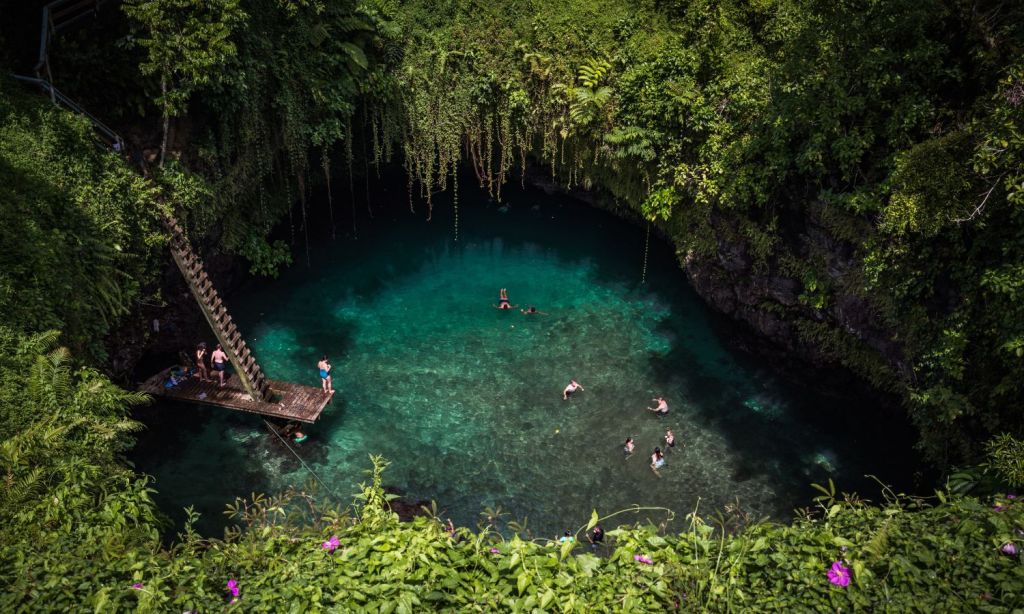When I visited Samoa for a week earlier this year, a local described it as Fiji, also an island nation in the South Pacific, but 20 years ago. Though Samoa has far less tourism and is far less known around the world, like Fiji, it has similar landscapes, activities and culture with strong family and community values.
“Whenever we had a visitor come over, my mom brought out her best mosquito net,” the local told me.
Those strong family and community values were something I witnessed throughout my trip to Samoa, which I took courtesy of Virgin Australia, which has five services from from Brisbane to Samoa per week. Ahead, I’m sharing other parts of Samoan culture and their general ways of living I noticed as a visitor. Here’s everything I wished I’d known about the country before travelling there at the start of this year.
Don’t Miss Out on Staying at a Beach Fale
I’d never heard the term “fale” before I went to Samoa, but by the end, I was well acquainted with the word. Beach fales were everywhere in Samoa. They refer to any house on the beach, with or without halls, but usually with a thatched roof. They’re used for daily visitors or overnight guests.
“Beach fales can be used for resting, bus stop shelters or just a place to hang out,” Fasitau Ula, Samoa Tourism Authority Australia’s marketing manager later told me. “Properly built fales are for hosting guests.”
I didn’t stay in a beach fale overnight, but I wish I had — I would’ve felt like I’d taken part in an authentic Samoan experience. Throughout my trip, I saw countless scenes of families crowded into them, having lunch, sleeping or relaxing.
You Have to Pay For All Attractions
Samoa has countless waterfalls — as stunning as they were, they all started to blend into one throughout my trip. But most of its nature attractions aren’t free to visit — they require an entrance fee. Also, some attractions have beach fales around them that you can rent hourly or for a half or full day.
Prices are in Samoan tala. To get to the Sua Ocean Trench, one of the nation’s most popular attractions, it costs 20 Samoan tala, roughly $11 AUD. Piula Cave Pool’s fee is 10 Samoan tala, about $6 AUD, while Afu Aau Falls is the same cost. Even many beaches in Samoa, you had to pay for.
Attending a Church Service Here Is Truly Memorable
One of the most special experiences on the trip was attending a Sunday morning church service. It had been pre-organised with the tourism board, but you can ask for your accommodation for the nearest church and its service times. If you;re planning on attending a service, bring all white as that’s the dress code.
The sermon saw the room singing and listening to the pastor before the crowd spilled onto the bright green lawn outside, overlooking the ocean. Families then went on to have barbecues at their homes. Many shops and attractions are closed on Sunday in Samoa as it’s a day of rest.
I loved seeing the white hats and starched suit skirts the women wore. Even the babies crawling down the aisle as they couldn’t sit still were dressed in all-white.
The Author of Treasure Island Lived in Samoa
Most of the activities and attractions in Samoa are outdoors — the island nation has few museums. One of its only is the Robert Louis Stevenson Museum in Apia. It’s in the former home of the Scottish author who wrote Treasure Island and Strange Case of Dr. Jekyll and Mr. Hyde.
Stevenson lived in Samoa for the last five years of his life. He was passionate about Samoan independence and became an advocate for its people. The two-floor museum displays the rooms where Stevenson and his family slept and lived.
Tattooing Is a Big Part of Their Culture
Finally, be prepared to see a lot of tattoos in Samoa — they’re an important part of the culture, viewed as a hallmark of manhood and womanhood. But unlike modern tattooing, getting the ink done in Samoa is a painful and long process.
The tattoos are given using handmade tools, made from bones, tusks, shark teeth, shells and wood. A waist-to-knee tattoo can take up to two weeks. I saw a few minutes of the tattoo process at Samoa Cultural Village in Apia.
Related: The Traditional Part of Samoan Culture I Wish I’d Tried When I Visited the Nation
Related: Want to Escape the Crowds in Fiji? Try These 5 Underrated South Pacific Islands Instead
Read more stories from The Latch and subscribe to our email newsletter.

